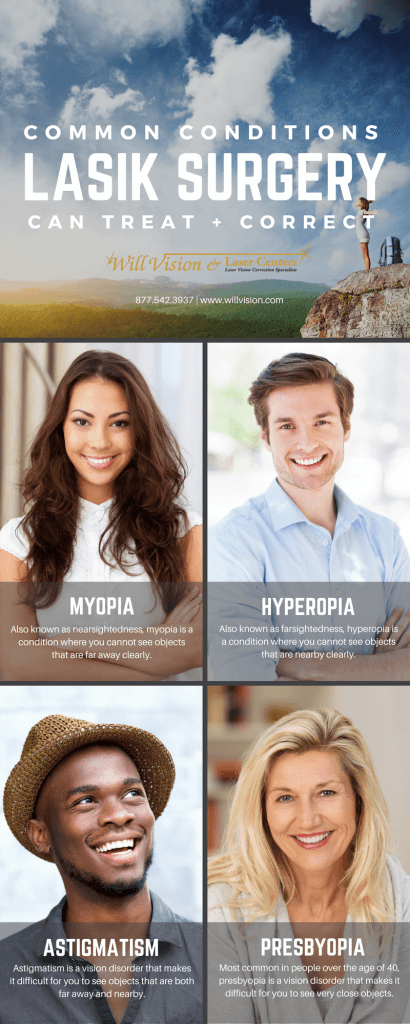How the Eye Works
The human eye is truly incredible. It provides us with a vast panoramic view of the world around us, a veritable kaleidoscope of color, and the ability to focus on objects from the tiny hairs on the backs of our hands to the stars in the sky – all without the need for batteries, cables or buttons. As a result, we can enjoy watching a spectacular sunrise over Mt. Hood while composing a text message to our friends or watching our children play on the beach while we read the latest best seller. To date, no camera or video system possesses the robust dynamic range, the incredible breadth of color rendering or the truly panoramic view afforded us by our eyes.
The eye is a marvelous organ that functions much like a sophisticated camera system. The cornea is the clear window located on the front of the eye. However, rather than just performing as a simple window it functions as a powerful lens, producing about 70% of the focusing power of the eye’s optical system. It is easily accessible and can have its focusing ability modified by Lasik . The iris is the colored part of the eye (blue, brown or hazel) and acts like an aperture or “f-stop” in a camera. It regulates the amount of light that can enter the eye and can also affect the eye’s range of focus. Located immediately behind the iris is the crystalline lens which further focuses light onto the retina. The retina functions like the film or image detecting microchip in a camera. It collects the light from the focused image, processes it and sends the partially processed data to the visual system in the brain via large specialized nerves. The brain then interprets the transmitted data in real time and creates what we call “vision”.
The Future's Right Before Your Eyes!
If you’re ready to take the next step in your journey to better vision, contact Will Vision & Laser Centers today. We’re excited to welcome you into our practice and for you to “See the Difference.”
Focusing Problems
Unfortunately, for some of us, our eyes come significantly out of focus. In earlier times these issues may have determined whether or not we became a scribe or cobbler versus a knight or warrior-hunter. In some cases, severe vision problems may have made us vulnerable to threats from wild animals or natural disasters. Of course all of that changed with the invention of glasses. In modern times, we can now treat many of these focusing problems with advanced laser vision correction procedures like Lasik.
Nearsightedness, or myopia, is a very common condition in which the eye is not able to focus well on distance objects while near items are clear. In severe cases the near point of focus may be only a few inches from the face. In most cases, nearsightedness is caused by the eye being too long or the focusing lens system being too strong. As a result, images are brought into focus in front of the retina. Typical treatments for myopia include glasses, contact lenses or Lasik.
- Near objects are clear while distance objects are blurred
- Caused by the eye having too much power or an eye that is too long
- Treated by reducing the focusing power of the eye
Farsightedness, or hyperopia, is less common than myopia in western civilizations and is the situation where distance objects are clear while near items may be blurred. Because the eye’s focusing system can often compensate for farsightedness, persons afflicted with hyperopia may have good vision in their teens, twenties or even thirties and not need glasses until they are older. In this situation the eye may be too short or the lens focusing system too weak to render an image on the retina, but rather creates a focal point that is located behind the retina. Similar to myopia, treatments for hyperopia include glasses, contact lenses or Lasik surgery.
- Distance objects are clear while near objects are blurred
- Caused by the eye having too little focusing power or an eye that is too short
- Treated by increasing the focusing capacity of the eye
Astigmatism is very common and most eyes demonstrate some degree of this optical condition. In this case the eye’s visual system is not spherical (round like a basketball) but rather is oval and shaped like a football. As a result, light passing in one optical axis has a different focal point than light passing through an axis located 90 degrees away. Eyes with astigmatism are often simply out of focus no matter where the object might be located – near or far. Astigmatism is also frequently associated with either nearsightedness or farsightedness further compounding the individual’s ability to see clearly. Person’s affected by astigmatism typically don’t have any focal point that is clear. As a result, both distant and near objects are blurred. Astigmatism is typically treated with glasses, special “toric” contact lenses that must rotate to the proper orientation on the eye or with advanced Lasik technology.
- The optical system is not round but rather is football shaped
- All light entering the eye is focused onto a different optical plane
- Objects at any distance are blurred
- Frequently occurs in combination with nearsightedness and farsightedness
No matter whether a person is afflicted with nearsightedness, farsightedness or astigmatism all eyes will suffer from a condition called presbyopia (prez-be-oh-pee-yah). Healthy young eyes have a highly robust dynamic range of focus due to the fact that the lens system located inside the eye can change shape. This change is shape is modulated by the brain’s feedback loop that causes a tiny ring of muscles that surround the lens to either relax or constrict thereby altering tension on the lens and changing its shape. When we are born this lens is very elastic and can focus on objects from the tip of our noses to infinity.
However, with each passing year the special proteins that make up the lens become changed and the lens becomes less and less flexible. As a result, our ability to focus on the tip of our noses gradually moves further and further out. Around age 45 for most people, the ability to focus on a computer or magazine or cell phone is compromised. Initially this can be compensated for by moving the object a little further out (i.e. getting longer arms) or increasing the ambient light (creating greater contrast). Ultimately, in order to see well the person must begin to use reading glasses. If they already wear contact lenses or glasses to correct their distance vision then they may need expensive and annoying bifocal or progressive glasses or wear reading glasses on top of their contact lenses. Until the introduction of the KAMRA™ corneal inlay, presbyopia has not been easy to treat using laser vision correction.
- Often confused with farsightedness
- Unlike farsightedness, presbyopia affects everyone typically in their mid 40’s
- Caused by the natural lens in the eye becoming less flexible as It ages
- Near tasks like reading a book, sending a text message or looking at a watch are affected
LOSS OF NEAR VISION – UNDERSTANDING AGE RELATED NEAR VISION LOSS
I Can’t Read Anymore!
During our 40’s, most people begin to notice that they can no longer see well when performing near tasks. Simple everyday things that they used to enjoy like reading a magazine, viewing a computer monitor or reading or sending a simple text message become increasingly frustrating. Although this problem can be overcome by using reading glasses, in our modern fast paced world where text messages and emails arrive nearly continuously, the need to find a pair of readers to view these important communications is both limiting and annoying. Worse yet, many people associate the need for “readers” with “old age” and the need to dangle readers by a chain around their neck or to retrieve them from a shirt pocket or their purse each time their cell phone vibrates only serves to reminds them that they are getting older. As a group we are much more generally more active than our parents and old fashioned solutions like reading glasses don’t mesh well with our highly technological fast paced world.
This loss of reading ability is called presbyopia (prez-bee-oh-pee-yah) and is an inevitable part of aging. Ultimately, presbyopia affects 100% of the population – including those that had perfect vision before.

What Causes Presbyopia?
Our ability to focus from distance to far is created by the natural lens located inside the eye just behind the iris. When we are young, it acts like a zoom lens or autofocus mechanism on a camera to automatically adjust our focus on those objects we want to see. This focusing is performed using a complex feedback loop involving the brain and retina and is dependent upon impulses from the brain causing tiny muscles in the eye to change the shape of our natural lens. This natural lens is composed of complex crystalline proteins that are both elastic and clear.
As we age, just like other parts of the body that become less flexible, the proteins in the natural lens also age and become stiffer. At first the muscles in the eye involved in focusing work harder, which can offset the rigidity of the lens but this effort may can cause headaches and focus lag when rapidly looking from close to far. Moving the object further away or “getting longer arms” can also temporarily improve the focus as can increasing the ambient light to create more contrast. Eventually, despite these new behaviors, the ability to see objects in our normal working range is no longer possible.
Presbyopia worsens as we age as the lens continues to become more and more inflexible leading to the need for stronger and stronger reading glasses. As a result, the need for reading glasses can progress from only needing them for fine print or low light to needing them throughout the day for any task within arm’s length. If the lens proteins, in addition to becoming more rigid also begin to lose their clarity, the eye is said to have developed a “cataract”. In some sense, the onset of presbyopia is an early form of cataract.
With age the loss of elasticity and flexibility of the natural lens results in an improper focus for near objects and blurred near vision. This condition is called presbyopia.
Other questions we answer on other pages:
To learn more, contact Dr. Brian Will in a one-on-one consultation to see which procedural options are best for you. Dr. Will will gladly answer any questions you have and provide you with valuable advice in a no-pressure, comfortable setting.



